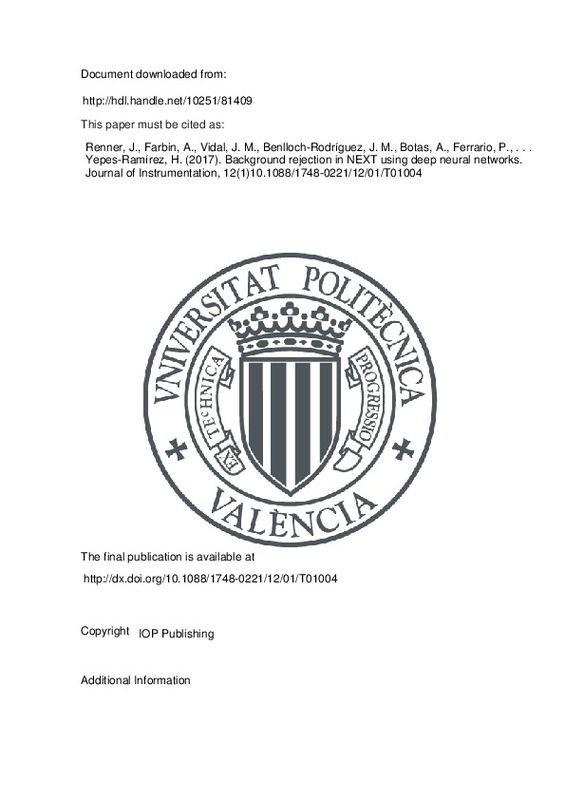Renner, J.; Farbin, A.; Muñoz Vidal, J.; Benlloch-Rodríguez, J.; Botas, A.; Ferrario, P.; Gómez-Cadenas, J.... (2017). Background rejection in NEXT using deep neural networks. Journal of Instrumentation. 12. https://doi.org/10.1088/1748-0221/12/01/T01004
Por favor, use este identificador para citar o enlazar este ítem: http://hdl.handle.net/10251/81409
|
Título:
|
Background rejection in NEXT using deep neural networks
|
|
Autor:
|
Renner, J.
Farbin, A.
Muñoz Vidal, J.
Benlloch-Rodríguez, J.M.
Botas, A.
Ferrario, P.
Gómez-Cadenas, J.J.
Álvarez, V.
Azevedo, C.D.R.
Borges, F.I.G.
Cárcel, S.
Carrión, J.V.

 Esteve Bosch, Raul
Esteve Bosch, Raul

 Herrero Bosch, Vicente
Herrero Bosch, Vicente

 Mora Mas, Francisco José
Mora Mas, Francisco José

 Toledo Alarcón, José Francisco
Toledo Alarcón, José Francisco
|
|
Entidad UPV:
|
Universitat Politècnica de València. Escuela Técnica Superior de Ingenieros Industriales - Escola Tècnica Superior d'Enginyers Industrials
Universitat Politècnica de València. Escuela Técnica Superior de Ingenieros de Telecomunicación - Escola Tècnica Superior d'Enginyers de Telecomunicació
Universitat Politècnica de València. Escuela Politécnica Superior de Gandia - Escola Politècnica Superior de Gandia
|
|
Fecha difusión:
|
|
|
Resumen:
|
[EN] We investigate the potential of using deep learning techniques to reject background events in searches for neutrinoless double beta decay with high pressure xenon time projection chambers capable of detailed track ...[+]
[EN] We investigate the potential of using deep learning techniques to reject background events in searches for neutrinoless double beta decay with high pressure xenon time projection chambers capable of detailed track reconstruction. The differences in the topological signatures of background and signal events can be learned by deep neural networks via training over many thousands of events. These networks can then be used to classify further events as signal or background, providing an additional background rejection factor at an acceptable loss of efficiency. The networks trained in this study performed better than previous methods developed based on the use of the same topological signatures by a factor of 1.2 to 1.6, and there is potential for further improvement.
[-]
|
|
Palabras clave:
|
Analysis and statistical methods
,
Double-beta decay detectors
,
Time projection chambers
,
cluster finding
,
Pattern recognition
,
calibration and fitting methods
|
|
Derechos de uso:
|
Reserva de todos los derechos
|
|
Fuente:
|
Journal of Instrumentation. (issn:
1748-0221
)
|
|
DOI:
|
10.1088/1748-0221/12/01/T01004
|
|
Editorial:
|
IOP Publishing
|
|
Versión del editor:
|
http://dx.doi.org/10.1088/1748-0221/12/01/T01004
|
|
Código del Proyecto:
|
info:eu-repo/grantAgreement/EC/FP7/339787/EU/Towards the NEXT generation of bb0nu experimets/
...[+]
info:eu-repo/grantAgreement/EC/FP7/339787/EU/Towards the NEXT generation of bb0nu experimets/
info:eu-repo/grantAgreement/MICINN//CSD2008-00037/ES/Canfranc Underground Physics/
info:eu-repo/grantAgreement/MINECO//FIS2014-53371-C4/
info:eu-repo/grantAgreement/MINECO//SEV-2014-0398/ES/INSTITUTO DE FISICA CORPUSCULAR (IFIC)/
info:eu-repo/grantAgreement/GVA//PROMETEO%2F2016%2F120/
info:eu-repo/grantAgreement/DOE//DE-AC02-07CH11359/
[-]
|
|
Agradecimientos:
|
The NEXT Collaboration acknowledges support from the following agencies and institutions: the European Research Council (ERC) under the Advanced Grant 339787-NEXT; the Ministerio de Economia y Competitividad of Spain and ...[+]
The NEXT Collaboration acknowledges support from the following agencies and institutions: the European Research Council (ERC) under the Advanced Grant 339787-NEXT; the Ministerio de Economia y Competitividad of Spain and FEDER under grants CONSOLIDER-Ingenio 2010 CSD2008-0037 (CUP), FIS2014-53371-C04 and the Severo Ochoa Program SEV-2014-0398; GVA under grant PROMETEO/2016/120. Fermilab is operated by Fermi Research Alliance, LLC under Contract No. DE-AC02-07CH11359 with the United States Department of Energy. JR acknowledges support from a Fulbright Junior Research Award.
[-]
|
|
Tipo:
|
Artículo
|







![[Cerrado]](/themes/UPV/images/candado.png)


